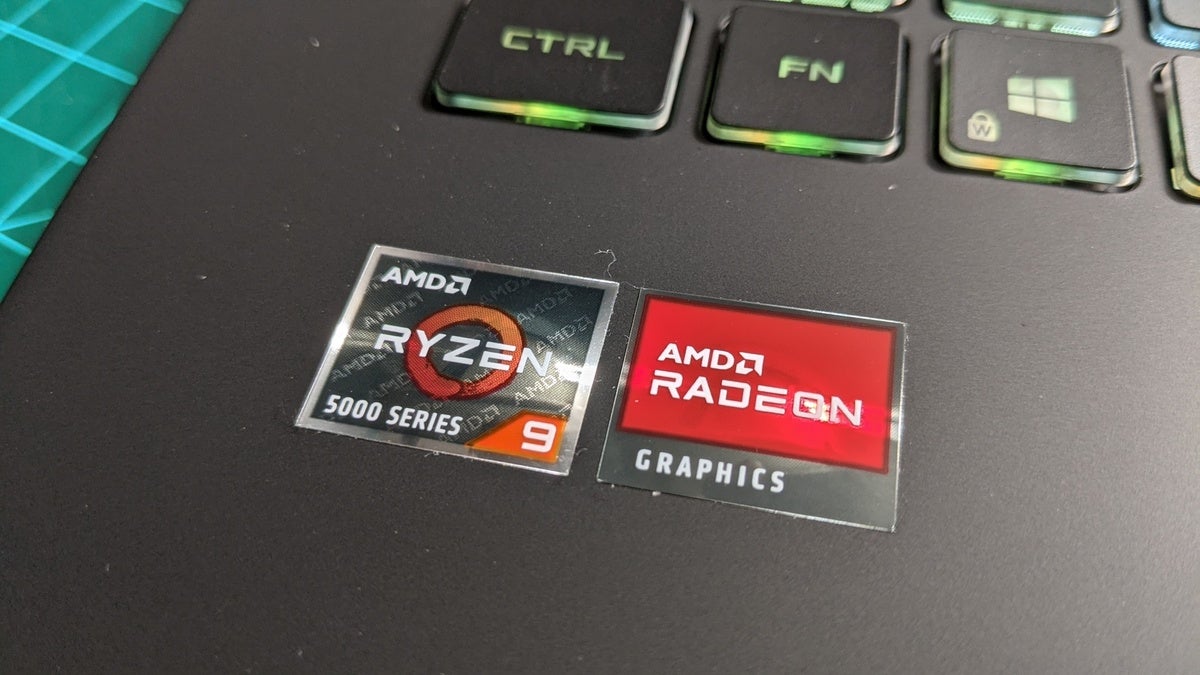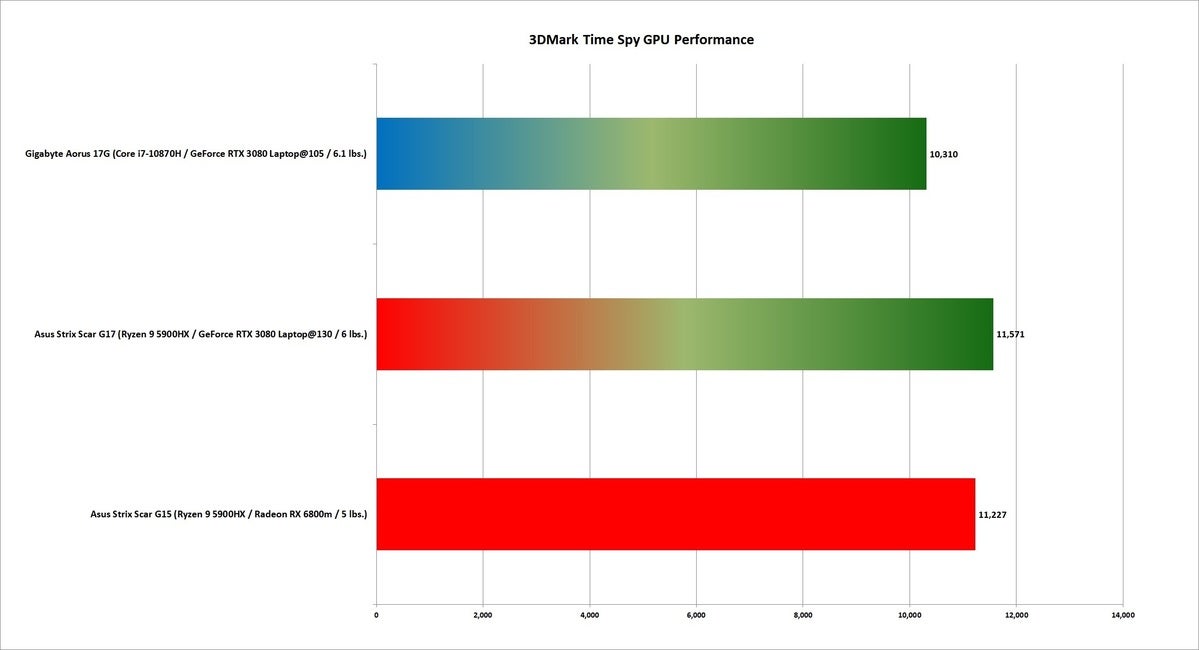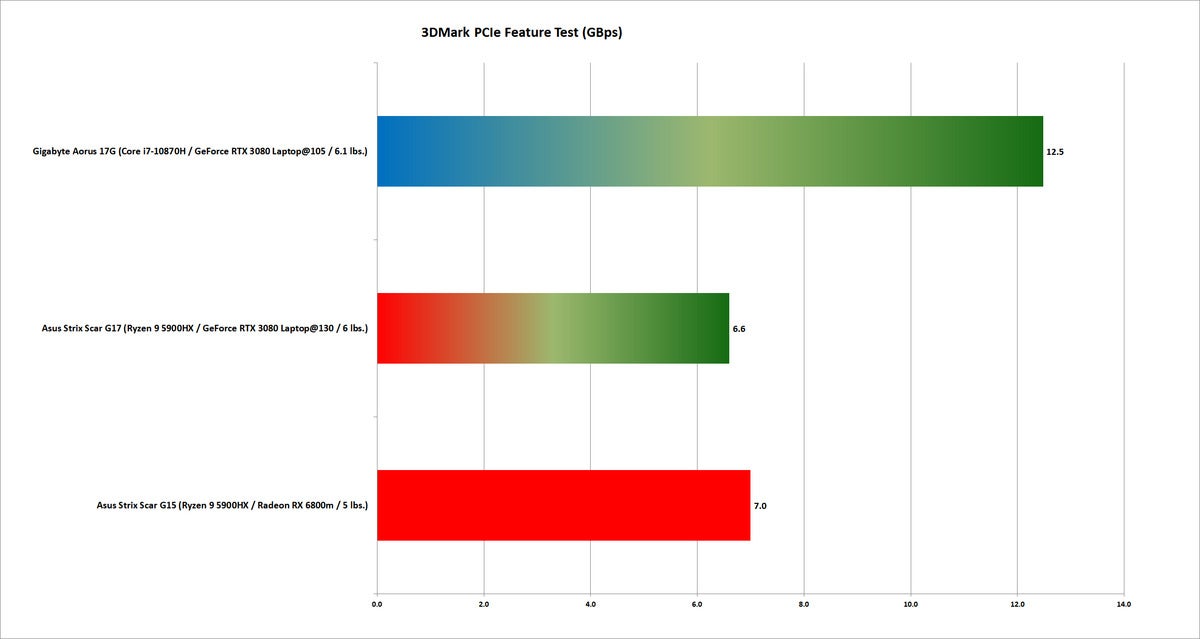If you think Nvidia’s GeForce has long had a lock on desktop GPUs, it’s nothing less than Fort Knox on gaming laptops, where it simply dominates all. That could change, however, with AMD’s new RDNA2-based Radeon RX 6000 GPUs, which promise solid competition to the high-flying GeForce chips.
To find out just how well AMD’s new GPU and CPU do, we took the new Asus ROG Strix G15 Advantage Edition around the block. If you’re looking for more CPU tests, we recommend that you read our review of Intel’s 11th-gen Tiger Lake H, where we look at the same CPU used in the G15.
What’s different in the ROG Strix G15 Advantage Edition is obviously the GPU: AMD’s Radeon RX 6800M, which features 40 compute units, 12GB of GDDR6 RAM, and 96MB of Infinity Cache on a 192-bit memory interface—and finally, real competition in gaming laptops.
 Gordon Mah Ung
Gordon Mah UngAll AMD inside. The badges on the Strix G15 Advantage Edition says everything an AMD fan wants to know.
How we tested
For the gaming tests we confined our tests to three nicely outfitted laptops that would fall into the “performance” category of gaming laptops. They aren’t sumo-wrestler beefy, but neither are they marathon-runner stringy:
- Gigabyte Aorus 17G with Intel 8-core Core i7-10870H, Nvidia GeForce RTX 3080 Laptop GPU with a TGP of 105 watts, and 16GB of GDDR6 RAM. The laptop also features 32GB of DDR4/2933 in dual-channel mode and a 1TB NVMe SSD, along with a 300Hz, 17.3-inch FHD screen. The laptop weighs about 6.1 pounds and is powered by a 230-watt power brick.
- Asus ROG Strix G17 with 8-core AMD Ryzen 9 5900HX, Nvidia GeForce RTX 3080 Laptop GPU with a TGP of 130 watts, and 16GB of GDDR6 RAM. The laptop features 32GB of DDR4/3200 in dual-channel mode and a 1TB NVMe SSD, along with a 360Hz, 17.3-inch FHD screen. The laptop weighs about 6 pounds and is powered by a 240-watt power brick.
- Asus ROG Strix G15 Advantage Edition with 8-core AMD Ryzen 9 5900HX and AMD Radeon RX 6800M with 12GB of GDDR6 RAM. The laptop also features 16GB of DDR4/3200 in dual-channel mode, and a 512GB NVMe SSD. It weighs 5 pounds and is powered by a 280-watt power brick. AMD spec’s the Radeon RX 6800M at 145+ Watts but let’s just say it clearly could use more.
 Gordon Mah Ung
Gordon Mah UngSexy doesn’t have to be thin. Despite its thick body, the ROG Strix G15 is relatively light and features eye-catching accents that can be swapped out.
Synthetic Performance
We’ll kick this off with UL’s popular synthetic 3DMark benchmark, which measures DirectX12 graphics performance. Although not an actual game, it’s a very reliable and very repeatable test. The scores also break down both the overall performance, which slightly factors in the CPU physics performance as well as pure GPU performance. For the charts below, the bars that are solid red indicate an all-AMD laptop, which is the Ryzen 9 5900HX and the Radeon RX 6800M. Bars with red and green indicate a Ryzen CPU with a Nvidia GPU, while a blue-and-green bar indicates an Intel CPU and Nvidia GPU.
The overall score for 3DMark Time Spy puts the ROG Strix G15 Advantage Edition with its all-AMD components in a pretty good spot, right between the other two laptops. That’s a solid win even if it doesn’t come out on top, since neither of the two GeForce RTX 3080 Laptops-based units are slouches.
 IDG
IDGLonger bars indicate better performance. Green indicates Nvidia components. Blue indicates Intel components. Red indicates AMD components.
Digging into pure GPU performance, we see the Radeon RX 6800M separated by just 3 percent from the 130-watt GeForce RTX 3080 Laptop GPU. With the GeForce RTX 3080 Laptop at a more relaxed 105 watts, the Radeon RX 6800M actually outpaces it by about 8.9 percent.
 IDG
IDGLonger bars indicate better performance. Green indicates Nvidia components. Blue indicates Intel components. Red indicates AMD components.
Ray tracing performance is the brave new world of gaming. It can greatly reduce the amount of work game developers have to do for better lighting and reflections, but it’s computationally expensive. While Nvidia has dedicated cores in its 20-series and 30-series GPUs for ray tracing, AMD uses its existing shader cores along with a dedicated ray accelerator unit—one for each CU.
AMD is still playing catch-up with Nvidia which jumped in with both feet with its 20-series GeForce cards. You can see the impact in 3DMark’s Port Royal, which uses Microsoft’s DirectX Raytracing to measure reflection and shadow performance. The Radeon RX 6800M is at a 21-percent deficit against the 130-watt GeForce RTX 3080, and is 13 percent slower than the 105-watt GeForce RTX 3080.
 IDG
IDGLonger bars indicate better performance. Green indicates Nvidia components. Blue indicates Intel components. Red indicates AMD components.
The story gets even worse for AMD as you increase the difficulty of the ray tracing. While Port Royal used DXR for just shadows and reflections, the newer 3DMark DirectX has since added a DirectX Raytracing test that is a “pure” ray tracing test. That means rather than use DXR for just lighting and shadows, the entire scene is ray-traced. With this much harsher (and perhaps unrealistic) test, the GeForce RTX 3080 Laptops come out 145 percent and 122 percent faster than the Radeon RX 6800M. That’s a crushing performance difference.
We say “unrealistic” because pure ray-traced modern games, and hardware with performance you’d want to play at, are likely years away still. Yes, it’s pretty amazing to see an entirely ray-traced Quake II RTX running, but that game came out in 1997.
Still, ray tracing is, and has been, the Achilles heel for Radeon on desktops, and it’s the same in laptops.
 IDG
IDGLonger bars indicate better performance. Green indicates Nvidia components. Blue indicates Intel components. Red indicates AMD components.
One last test from 3DMark we should show you is the PCIe bandwidth test. This measures the amount of data that can be passed across the PCIe bus between the GPU and CPU. Although the desktop CPUs feature PCIe 4.0, the laptop versions don’t. The laptop Ryzen CPUs also feature fewer lanes, with the PCIe 3.0 capped at x8 versus the x16 of Intel CPUs. With both GeForce RTX 30-series and Radeon RX 6800 featuring 16 lanes of PCIe 4.0, 3DMark’s PCIe feature test shows you that bandwidth cap in technicolor. Our chart doesn’t even include Intel’s latest 11th-gen Tiger Lake H CPUs, which feature 16 lanes of PCIe 4.0 and push 20GBps.
The good news for AMD is that it’s still very difficult to find modern games that use that much bandwidth. How long that holds isn’t known, but for most people playing today’s games, it’s not a big deal—just something to be aware of for the future.
 IDG
IDGLonger bars indicate better performance. Green indicates Nvidia components. Blue indicates Intel components. Red indicates AMD components.
Gaming Performance
If you’ve had enough of the synthetic results, we’ll cut to the actual gaming performance. For these initial tests, we opted to disable DXR. We did this because the overwhelming amount of PC games still don’t use it, and there’s more value for most users in seeing conventional gaming performance.
If, however, you think ray tracing is the future you want to bet on, we’d recommend that you simply stop reading and jump aboard the GeForce train, because in the here and now, Nvidia’s early bet gives it a major advantage.
Although AMD and Nvidia are pushing their top GPUs as best suited for 1440p gaming, the vast majority of gaming laptops today are actually 1080p, using high refresh rates of 144Hz, 240Hz, 300Hz, or 360Hz. Because you can’t play at a higher resolution than the one in your laptop (unless you’re using an external display), all of our testing was conducted at the native resolution of the laptops: 1080p.
The first game result is from Shadow of the Tomb Raider set to its highest preset. Even with ray tracing disabled, both the GeForce chips lead the way by 9 percent and 13 percent, respectively. The Radeon RX 6800M comes up close behind.
 IDG
IDGLonger bars indicate better performance. Green indicates Nvidia components. Blue indicates Intel components. Red indicates AMD components.
Moving on to Metro Exodus and using the Extreme preset, we actually see the Radeon RX 6800M pull dead-even with the 105-watt GeForce RTX 3080 in the Intel 10th-gen laptop, while the 130-watt GeForce RTX 3080 paired with the same Ryzen 9 5900HX is about 10.5 percent faster. Again, Radeon RX 6800M doesn’t win, but being in the neighborhood of Nvidia’s top GPU is nothing to scoff at.
 IDG
IDGLonger bars indicate better performance. Green indicates Nvidia components. Blue indicates Intel components. Red indicates AMD components.
We did indeed see incidents where Team Red pulled ahead. Red Dead Redemption 2, for example, saw the Radeon RX 6800M about 7.5 percent ahead of the 130-watt GeForce RTX 3080 Laptop paired with the same Ryzen 9, and 17 percent faster than the 105 watt GeForce RTX 3080 Laptop with its 10th-gen Intel CPU.
 IDG
IDGLonger bars indicate better performance. Green indicates Nvidia components. Blue indicates Intel components. Red indicates AMD components.
Up next is Horizon Zero Dawn set to high quality. We again see the Radeon RX 6800M sandwiched between both GeForce RTX 3080s, which we again regard as a solid performance.
 IDG
IDGLonger bars indicate better performance. Green indicates Nvidia components. Blue indicates Intel components. Red indicates AMD components.
The next game is Far Cry New Dawn, which actually sees the 105-watt GeForce RTX 3080 with the 10th-gen Intel CPU leading the pack. The Nvidia/Intel combo, in fact, is a decent 14.5 percent faster than both Ryzen-based laptops. Why? Although most games tend to be very GPU-focused, the Far Cry series has tended to run better on Intel-based CPUs. On the desktop Ryzen 5000 that’s no longer really true, but the laptop Ryzen version is not quite the same formula, and we see the Intel advantage crop up again.
Even if the CPU is a significant factor here, the fact that we have both Asus ROG Strix laptops using the same Ryzen 9 5900HX is perhaps the better comparison. When both are using the same Ryzen 9, we actually see a very competitive race between GeForce and Radeon.
 IDG
IDGLonger bars indicate better performance. Green indicates Nvidia components. Blue indicates Intel components. Red indicates AMD components.
Keep reading for more gmaing benchmarks.

Be the first to comment